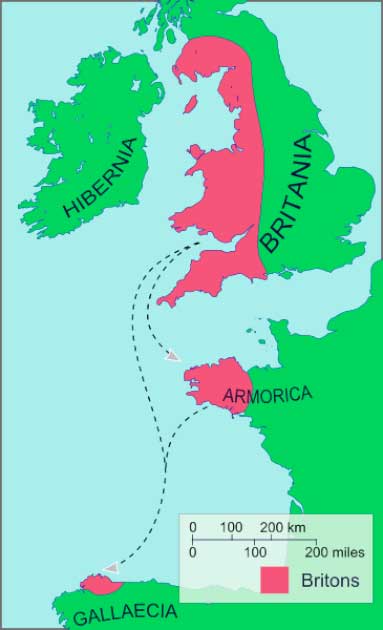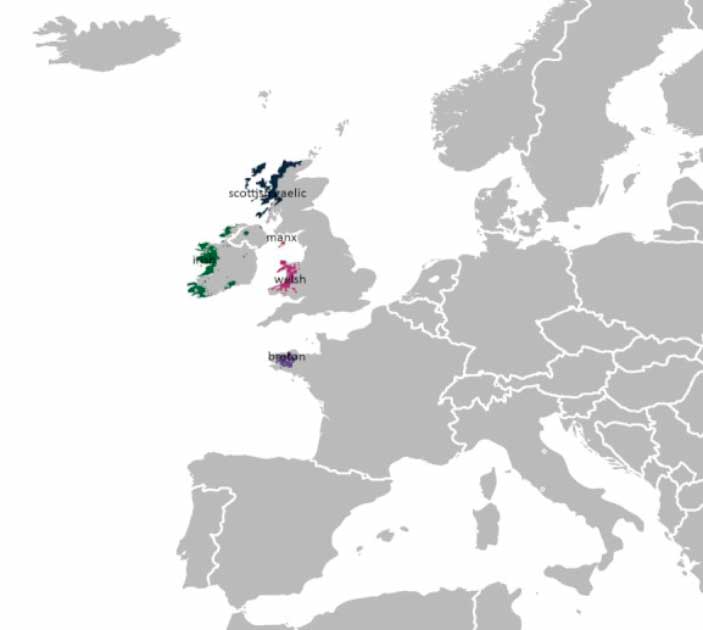There are 7,151 living languages across the globe, which have been categorized into 142 different language families. Of the 142 families, the six most prominent language families as of 2021 are Afro-Asiatic, Niger-Congo, Trans-New Guinea, Austronesian, Sino-Tibetian, and Indo-European.
The Indo-European family is grouped into ten different branches. One branch of this family is Celtic (Proto-Celtic). Modern Celtic languages include Manx, Irish, Scottish Gaelic, Welsh, Cornish, and Breton. Manx, Irish and Scottish Gaelic are considered “Goidelic Languages,” while Welsh, Cornish, and Breton are considered “Brythonic Languages.”
These Brythonic languages once dominated the British Isles and parts of continental Europe, but today are hardly spoken at all. What happened to cause them to die out?
Brythonic
The modern Celtic languages are broken down into two groups: Goidelic and Brythonic. Brythonic, also known as Brittonic Languages or British Celtic, is defined as “of, relating to, or characteristic of the Celtic languages that include Welsh, Cornish, and Breton.”
Brythonic languages derived from the Common Brittonic language spoken across Great Britain during the Iron Age and Roman periods. Today the Brythonic languages that are still spoken are Welsh, Cornish, and Breton.
Brythonic languages are believed to have been spoken before the Romans invaded Great Britain. During the period of Roman occupation in present-day England and Wales, Common Brittonic borrowed a lot of Latin words. Around 800 of the Latin Ioan words have managed to survive in Welsh, Cornish, and Breton.

Following the period of Roman occupation, linguists and historians believe that Common Brittonic split into two different dialects based on location (Southwestern and Western dialects). As time passed and successive foreign languages brought their distinctiveness to the British Isles, Brythonic evolved and differences started to appear.
Brythonic languages in England, the Isle of Man, and Scotland began to become displaced in the 5th century. This displacement continued through the settlements of the Germanic peoples and the Irish-speaking Gaels.
By 1129, one form of Brittonic language known as Pictish was utterly extinct. It is assumed that the displacement of Brythonic languages occurred across Britain except in Cornwall and Wales.
The migration of Germanic settlers, the Anglo-Saxons, in early medieval England arrived speaking Western Germanic dialects that are now collectively referred to as “Old English.” This began around the 5th century when Roman power in Britain began to collapse.
These early Celtic speakers fled to Brittany, France, or the highland areas of Britain and did not follow the rest of Britain that switched to Old English. They survived in smaller pockets and communities as Old English took hold.
Welsh
The Brythonic language of Welsh is a native language in Wales and is still spoken by some people in England and (unexpectedly) the Welsh colony of Y Wladfa in Argentina. Of all three of the Brythonic languages, The United Nations Educational, Scientific, and Cultural Organization (UNESCO) ranks Welsh as the only Celtic language still spoken and not endangered.
The most recent population census in Wales reported that “29.5% of people aged three or older can speak Welsh. This figure equates to around 892,000 people” in Wales alone. This Brythonic language has been reported to be spoken by members of the Welsh diaspora in England, Canada, Australia, New Zealand, and the United States.
During the middle ages (between 1000 and 1536), the version of “spoken Welsh” was known as Middle Welsh. One of the most famous manuscripts of this period in Britain, the Mabinogion, was written in Middle Welsh.
The next significant period in the history of this Brythonic language is from the rule of Henry VIII and lasted to the modern period. The language was banned and was no longer an administrative language, but that did not stop people from speaking Welsh, teaching their children the language, and using Welsh at home. Because people ignored the laws banning Welsh, the language has been able to survive today.
Cornish
The second of the surviving Brythonic languages is Cornish. Unlike Welsh, which is a native language, Cornish is considered a “revival language.” Cornish became extinct as a “living community language” in Cornwall by the end of the 18th century.
A living community language is a language that is spoken by members of minority groups or communities within a major language context. Cornish is unique because while the language became extinct, the language and the speaking abilities were passed on within families and among individuals. The revival period began in the early 20th century.
This Brythonic language has been adopted as a second language for speakers, and “a very small number of families now raise children to speak revived Cornish as a first language.” Cornish is considered to be an important part of Cornish culture, heritage, and identity.
Although this Brythonic language has seen a slight revival, UNESCO considers Cornish to be Critically Endangered, one step above total extinction. Scholars cite the 1904 publishing of the book “A Handbook of the Cornish Language” by Celtic language scholar and Cornish cultural activist Henry James as the starting point of the revival movement.
Cornish may be helped in its revival in that it has a sister language, Breton. A sister language is defined as “the relationship between languages and dialects in which speakers of different but related varieties can readily understand each other without prior familiarity or special effort.” Some examples of sister languages include Russian/Belarusian/Ukrainian and Slovakian/Czech/Polish.
As of 2022, the number of people who can speak Cornish is believed to be around 3,500 people. This number is an estimation because there were a reported total of 464 native Cornish speakers (all residing in Cornwall); this does not include those whose second language or have learned Cornish to some degree.
Breton
Cornish’s sister language, Breton, is a Southwestern Brythonic language spoken in Brittany, part of modern-day France. Breton is the only Celtic language still “widely spoken on the European mainland” due to an insular branch of Brythonic language speakers.

Britons who migrated to France in the Early Middle Ages brought Breton from Great Britain to Armorica (the ancient name for the coastal region of France that includes the Brittany Peninsula). The number of Breton speakers has significantly decreased over time, and UNESCO classifies this Brythonic language as Severely Endangered. That being said, a percentage of children in the area attend bilingual classes/schools.
Breton is spoken in Lower Brittany and for centuries was spoken by the upper-class from the 9th through the 12th centuries. However, during the French Revolution, there were government policies put into place that favored French over regional languages like Breton.
The revolutionaries believed that the upper-class and the monarchy preferred speaking in regional languages to “keep the peasant masses under-informed.” Breton then became the language of commoners in Lower Brittany because the nobility and upper classes adopted French as their new language.
At the start of the 20th century, half of the population in Lower Brittany spoke only Breton, and the other half of the population was bilingual. A survey in 1997 reported that around 300,000 people in Lower Brittany spoke this Brythonic language, and approximately 190,000 of those speakers were 60 years old or older.
In 1977, “Diwan schools” were created to teach children Breton through immersion. Since then, Diwan schools have offered full-immersion primary and part-immersion secondary schools for thousands of students in Brittany. It should be noted that Diwan schools do not receive any funding from the French government.
While Breton speakers have grown due to Diwan schools and a small Breton revival, it is the only Brythonic language that is not considered an official or regional language by a national government. France refuses to recognize other regional languages, and the official language of France is French, nothing else.
Top Image: Brythonic as a language was once spoken commonly, and attempts are being made to revive it. Source: Heartland Arts / Adobe Stock.